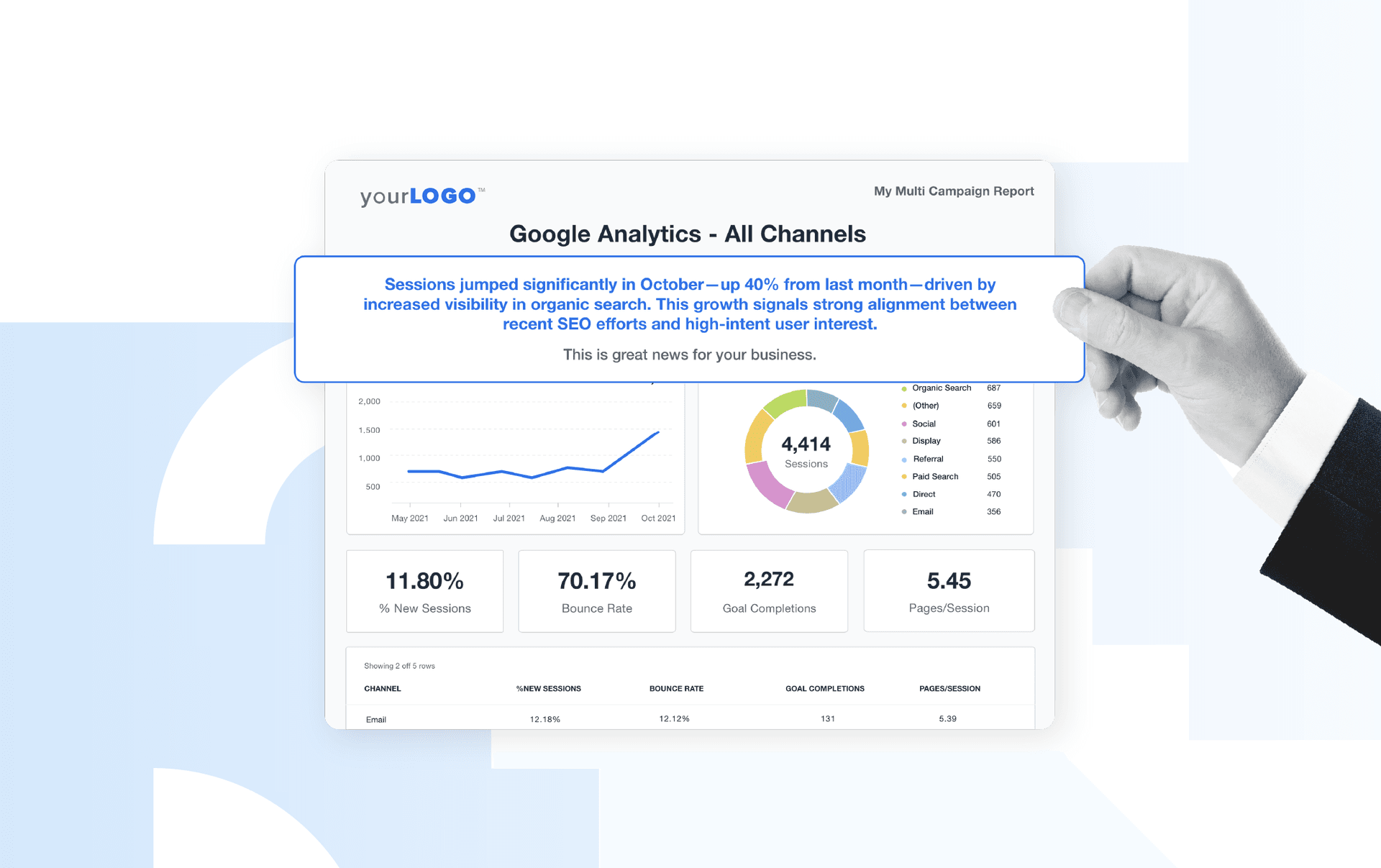Table of Contents
QUICK SUMMARY:
Tips for managing a remote team include encouraging effective communication, setting clear expectations, and maintaining team morale. Managing a remote marketing team requires unique strategies to promote productivity and collaboration across different geographical locations. This article shares seven essential tips to help marketing agencies successfully manage their remote teams, emphasizing the importance of flexibility, communication, and ongoing improvement.
Let's face it. The era of the cubicle and water cooler gossip is almost extinct. A new breed of warriors is here. These are the professionals who, clad in their pajamas, conquer marketing campaigns from their cozy nooks at home, cafes, or even on the go! They're the remote team members, reshaping how we perceive the workforce and redefining the future of work.
The pandemic upended the traditional ways of working, and marketing agencies are no exception. The shift towards remote work has been a game-changer, allowing agencies to tap into talent beyond geographical boundaries and offer a flexible work environment that employees crave. However, remote work also brings unique challenges, and managing a remote marketing team is challenging.
According to Rony Mirzaians, Managing Partner at Softline Solutions, finding the right people who meet professional and cultural standards is the biggest challenge faced by agencies. But with the remote work trend here to stay, agency leaders must adapt to new ways of managing their teams.
Embracing the Remote Working Era
Managing remote teams in a digital marketing setting–that's the challenge that keeps the lights on late into the night for some agency leaders. How do you ensure the creative minds that fuel your clients' marketing campaigns are consistently firing on all cylinders when they are spread across time zones, maybe even continents?
It's like trying to conduct a symphony, where each musician plays their own tune in a different room. But when done right, the music comes together in a harmonious masterpiece. That's the art and science of managing remote teams. Yes, it feels like a tall order, but let's face it, it's no longer a luxury or a 'perk.' In this digitally charged era, remote working is the name of the game.
Now, this isn't a guide for your garden-variety challenges of remote team management, like what video conferencing tool to use or how to schedule a team meeting across multiple time zones. This is about getting to the core, the fundamental factors that can make or break your success as a leader of remote teams.
We are delving deep into the nuts and bolts of maintaining team synergy, fostering a sense of belonging and purpose, ensuring your remote team members are surviving and thriving, and contributing to the overall success of your client's marketing campaigns.
Through this journey, remember: every orchestra needs a maestro. And with this guide in your arsenal, you're well on your way to being that maestro. So, get comfortable, and grab a cup of coffee (or two) because we're about to dive in.
7 Tips for Managing a Remote Team
As we approach the complex evolution of remote working, the road is often a steep uphill climb. But every seasoned mountaineer knows, it's not just about the climb, it's also about the gear. Similarly, for remote managers gearing up for the challenge, a robust toolkit makes the difference between stumbling blocks and stepping stones.
Remember, these remote team management tips are not just off-the-shelf solutions but strategies tailored to help you lead a remote team in this brave new world of work.
Over the next few sections, we will explore tried and tested tips that can help you steer your remote team with confidence and ease. These insights aren't about just keeping the wheels turning but about gaining momentum, not merely keeping your employees working remotely but making them thrive.
Before we venture forth, keep this in mind: managing a remote team isn't just about adapting to new ways of working, it's about reshaping your leadership style. It's about redefining what it means to be a manager in an era where teams share a screen instead of an office.
1. Recognize Challenges Faced by Remote Employees
Many employees find it much easier to attain a work/life balance by working from home.
But that doesn’t mean there aren’t some challenges to work through. Some of the challenges remote workers may face include:
Distractions. When working from home, employees may be distracted by family members, pets, and other things that can pull focus to other things while working While distractions–such as laundry, Netflix, or social media, can be a problem for those who work in a remote setting, most of them they can also be a problem for those who work onsite. After all, the term “water cooler talk” didn’t create itself.
A sense of isolation or disconnectedness. This can be particularly impactful to any extrovert on your team. Remote workers may feel disconnected from their coworkers unless regular efforts are made to interact on calls using Zoom or Microsoft Teams.
Miscommunication. When coworkers communicate through email or text, it sometimes triggers a domino effect of miscommunication. Since there are no nonverbal cues–such as body language and facial expressions–what’s expressed in the message is far more open to misinterpretation.
Time management. Employees who are working off-site need to manage their own time. Some employees adjust naturally to this requirement, but managers need to be able to recognize when staff members lack the self-discipline for remote work.
Difficulty disconnecting. Remote work can make it harder to disconnect from work. After all, the laptop is just sitting there, only a few feet away, at all times. This often leads to longer work hours, difficulty establishing a healthy work-life balance, and–eventually-burnout.
Agency managers must understand and empathize with employees’ challenges inside or outside the office. You may have the urge to micromanage, but it’s important to resist that urge. While you might prefer to be able to clearly see what team members are doing, you wouldn’t actually look over an employee’s shoulder all day long if they were in the office. Would you?

A remote staff values autonomy and the ability to set their own pace and schedule. Don’t assume employees aren’t being productive without direct supervision.
Read more: 5 Productivity Killers to Avoid at an Agency
2. Set Productivity Standards and Clear Expectations
As a manager, you’re responsible for setting clear expectations and standards for your team’s marketing productivity. Each employee’s job responsibilities should be well-defined and documented, including milestones and performance goals. To have a clear understanding of what’s expected of them, some things your staff needs to know include:
What needs to get done
How often to check in
How to track their time
What level of supervision is expected
How to demonstrate productivity
The best way to get in touch with you
Managing remote employees requires a shift in thinking compared to traditional office work since you can’t base your assessment of an employee’s performance on the activity you can observe during the day.
“Butts in seats” is no longer a valid measurement of employee productivity or engagement. And, really, it never was.
Instead, focus on what’s being completed, if it’s being completed on time, and whether it meets quality standards. While you still need to hold employees accountable for completing tasks and meeting deadlines, there can no longer be an emphasis on the number of hours spent at the desk or when those hours take place.
As the leader of your team, you’re responsible for putting tools in place that make it possible for employees to be successful in a remote role. This may include providing written policies and procedures manual or instructions on who they should contact for help if you’re not available.
Your HR department may also provide a written remote work policy that clarifies behavior that’s acceptable and not acceptable.
3. Promote Open and Frequent Communication
Much of the work of marketing agencies requires collaboration. This means it’s imperative for managers to set up open and frequent communication, which can be done through email, video conferencing, chat, or phone.
Managers should be visible and available as much as possible. If you have employees in different time zones, they still need to be able to reach you or someone who backs you up so that they can get a prompt answer if they have a question. Things to consider to provide regular communication include:
Scheduled team meetings. Plan to meet regularly with your remote teams to keep everyone on the same page and to help remind everyone that you’re all working together toward a common goal. Be honest and open so that your team knows they’re being kept informed of changes that may be happening within the company and things that are going on with other members of the team, such as upcoming projects or changes in job duties.
One-on-one meetings. Regular one-on-one meetings with the individual team member give you a chance to hear their individual concerns, especially if they need to talk about something they don’t feel comfortable bringing up in front of the whole group. The time given to each employee can be as short as ten to fifteen minutes once or twice a week. While some employees may need more routine interaction than others, the important thing is to touch base with every employee regularly.
Cross-departmental meetings. Making sure that people from different departments within the agency interact helps break down silos and promote collaboration between different teams. This can be especially important in a remote work environment where employees may not have as many opportunities for spontaneous interaction.
Be sensitive to the fact that requiring cameras to be on for every meeting is a form of micromanagement and may be draining to remote employees. Consider requiring cameras at some but not all meetings.
Regular communication is key to keeping employees motivated and connected. At team meetings, consider using humor and icebreakers to help everyone to feel engaged.
And managers should have a clear, well-planned agenda when leading meetings and should set expectations ahead of time, like whether cameras should be on or off. Finally, instruct participants to mute themselves when not speaking so that the entire team isn’t distracted when one team member’s dog decides that the delivery person has been sent from an alien world to invade their home.
4. Do Virtual Team-building Activities
When most or all of your staff is working remotely, coworkers may have a hard time getting to know each other. With no chance of camaraderie at the water cooler, managers need to provide ways for employees to interact and form connections.
This means prioritizing virtual team building, which can boost employee engagement and morale. Interacting for team building exercises is different than routine staff meetings and may include:
Attend brief daily Zoom meetings at the beginning of the day for the staff to touch base with each other about what’s on their mind, either inside or outside work.
Have a virtual dinner party with meals delivered to your employees that you all eat together over video conferencing.
Attend an online team-building event together, such as a painting workshop, trivia contest, or cooking class.
Host lunch and learns to share insights on a particular trend or development in the industry, such as the sudden explosion of AI data analysis tools.
The idea is to get together to do something that’s fun and friendly. Virtual team building is a wonderful way to remind your employees that they are a connected team, and it’s great to give them a chance to get to know each other in a relaxed experience.
While team building might be a little more challenging for a remote agency workforce, there’s no reason colleagues can’t strengthen their bonds through virtual team building.
5. Provide Accessible Tools and Technology
Advances in technology have made it possible to have seamless interactions with people who aren’t working onsite and may not be working anywhere near you geographically. Remote workers need access to a computer, an internet connection, and digital conferencing software. Some workers may need access to a printer or a phone and headset.
Communicate with your team which communication channels to use for video conferencing or messaging. The software being used should be easy to use and allow collaboration. Some of the software and remote work tools that help with team interactions include:
Here are just a few productivity tools that can be helpful when managing a remote agency:
Communication and collaboration tools: Like Slack, Microsoft Teams, or Zoom help keep your team connected and engaged.
Project management software: Like Asana, ClickUp, or Trello help track tasks, deadlines, and progress in real-time.
Time-tracking tools: Like Toggl or RescueTime monitor productivity and identify areas where your team may need more support or training.
Cloud-based storage: Like Google Drive or Dropbox ensure that everyone has access to the files and resources they need.
Password managers: Like LastPass or 1Password keep your team's login credentials secure and organized.
When managing a remote team, security is always a concern. Your agency may allow remote workers to use their own computers, or they may require them to use a company computer for security reasons.
Using personal devices raises the risk of sensitive data being shared over unsecured channels, and working remotely raises the risk of employees using unsecured networks and not having the expertise to secure data.
As hackers become more and more sophisticated, companies need to follow consistent security controls, such as using virtual private networks to access company data. Remote work policies should be documented and followed, and there should be an ongoing security awareness program.
6. Build Trust
Relationships are built on trust, including professional relationships. When you’ve made good hiring decisions, there’s no reason not to trust your team. Managers sometimes unintentionally send signals to employees that imply a lack of trust. Examples of these include:
Continually asking for progress reports, which lets remote workers know you don’t trust them to do the job they’re being paid to do
Not listening to suggestions from others
Failing to admit you’ve made a mistake
Avoid acting like you have all the answers, and be open-minded to input from the members of your team. Be sure to give credit to others when they have a good idea or suggestion.
The team member need to know you’re trustworthy, so you need to give them reasons to trust you.
Make sure your actions align with the things you say. Be honest and transparent in your communications. Don’t forget to relay information to staff. In today’s digitally-enabled world, workers being offsite is not a good excuse for a communication breakdown.
7. Implement Remote-Friendly Policies
Building an environment that supports remote work is more than just handing over a laptop and a login credential to your team members. It's about creating policies that foster productivity, inclusivity, and well-being in the virtual workspace. Here's how you can manage remote workers by crafting remote-friendly policies.
Set Ground Rules and Create Boundaries
Every game needs rules, and so does remote working. These ground rules serve as the foundation of your remote management style, setting the tone for how your team operates. From expected work hours to communication protocols, these rules bring clarity and consistency.
Encourage Regular Breaks
In an office environment, natural breaks occur–coffee breaks, lunchtime, small chats. However, while working remotely, team members may find themselves glued to their screens for extended periods. A policy encouraging regular breaks can avoid burnout and boost productivity. After all, the best ideas often come during a break, not in front of a screen.
Establish Virtual Meeting Etiquette
From cats making guest appearances on video calls to embarrassing background noises, we've all been there. Establishing a virtual meeting etiquette helps manage these scenarios. This policy can cover aspects like punctuality, background noise, and video usage. The goal is to make video calls efficient, respectful, and less stressful.
Allow for Flexibility and Autonomy
One of the biggest advantages of remote working is the flexibility it provides. A remote-friendly policy should recognize and reinforce this. Flexibility in work hours, recognizing different time zones if your team is spread across geographies, and understanding personal commitments, all come into play. This autonomy can motivate team members, improving their work output and job satisfaction.
Support Mental Health
Managing employees remotely also means being attentive to their mental health. This can include offering resources for stress management, providing access to online therapy sessions, or simply encouraging open conversations about mental health. A remote-friendly policy should act as a safety net, assuring your team members that their mental well-being is a priority.
In a nutshell, implementing remote-friendly policies isn't about a rulebook as thick as a brick. It's about understanding the unique challenges of remote working and finding ways to turn these challenges into opportunities. It's about leveraging the perks of remote working to create a happy, productive, and connected team. After all, a team that feels supported and valued can scale not just the heights of productivity but also of creativity.
Understand the Significance of Effective Management in a Remote Setting
As the digital world spins faster every day, the borders that once defined the traditional office are fading. Yet, as we chart this unexplored territory, the need for effective management in a remote setting has never been more critical.
Navigating the Complexities of Remote Teams
The journey to the rose garden of managing remote teams is not without its share of thorns. While the autonomy and flexibility that remote working provides can unleash untapped potential, it also brings unique challenges to the forefront.
Maintaining productivity, encouraging engagement, and fostering a sense of belonging among team members spread across different geographies are not just boxes to tick but foundations to build.
How to Manage Remote Employees Without Face-to-Face Interactions
In a world where a digital handshake is becoming as common as a traditional one, managing remote employees without face-to-face interactions is a skill leaders must master. This shift from the physical to the virtual workspace radically transforms how leaders manage remote employees.
In a remote environment, the line between professional and personal life can blur, making it crucial for leaders to strike a balance between being supportive and overbearing. The aim is to effectively manage remote employees, guiding them to respect their autonomy while ensuring accountability and maintaining high work standards.
But how do you build rapport with your team members when you don't bump into them in the corridor or share a coffee break? The answer lies in the intentional and thoughtful effort to maintain a human connection, even in a remote environment. This means having casual conversations, showing interest in their life outside work, and recognizing their achievements. It's about replicating the 'water cooler chat' virtually.
Not being able to communicate face-to-face also calls for adapting communication styles. Body language, tone of voice, and facial expressions are lost in emails and instant messages. Leaders must therefore emphasize clear, concise, and transparent communication. Regular team meetings, one-on-one check-ins, and open feedback channels ensure every team member feels heard and included.
Drive Performance and Accountability
Without the constant physical presence of a supervisor, how do you ensure your remote team members are not just surfing the web or watching Netflix during work hours?
Trust is the key here. Trust your employees to manage their time effectively and implement mechanisms for monitoring performance that do not infringe on their personal space. Tools that track progress and outcomes, rather than hours, are a more respectful and effective way to drive accountability in remote working.
In essence, managing remote employees without face-to-face interactions is about balancing autonomy and accountability, professional demands and personal connection, and guiding the team with giving them the space to grow. It's a tightrope walk, but with the right approach, one can walk it with grace and poise.
Building Resilience and Adaptability in a Remote or Hybrid Team
Building a resilient and adaptable team is vital in the ever-changing dynamic of remote working. A resilient team weathers any storm, be it a bad internet connection or a significant shift in a client's marketing strategy. On the other hand, an adaptable team thrives in the face of change, pivoting and course-correcting as the situation demands.
Leaders must cultivate these traits among their remote team members, creating an environment that encourages learning from mistakes and bouncing back stronger. This resilience and adaptability not only benefit the team but also contribute to the overall success of the client's marketing campaign.
Remote Management: The Litmus Test of Leadership
In the final analysis, managing a remote team is the litmus test of leadership. It's not just about checking work progress or keeping team members in the loop. It's about fostering a culture of trust, facilitating effective collaboration, and maintaining the motivation and morale of the team. Remote management requires empathy, patience, and a keen understanding of each team member's strengths and challenges.
Mastering the art of remote management can be daunting, but remember, even Rome wasn't built in a day. With persistence, commitment, and a healthy dose of humor, leaders can ensure their remote or hybrid team not only survives but thrives in this new era of work. After all, isn't turning challenges into opportunities what leadership is all about?
Closing Thoughts
Managing a remote agency workforce may require some trial and error, but at Softline Solutions, we've found that it's well worth the effort. Flexibility and communication are key, and processes for managing a remote team should be continuously tweaked and improved upon.
The benefits of having remote workers are significant. Not only does it save on the overhead of office space, but it also allows for a more diverse pool of talent to be tapped from different locations. Moreover, offering remote work options can improve job satisfaction, employee retention, and work-life balance.
To create and manage successful remote teams, it's important to consider implementing some of the suggestions provided in this article. By doing so, you can help your agency run more effectively and efficiently and create an environment that fosters growth, productivity, and success.
So, whether you're managing a fully remote team or a hybrid team, embrace the benefits of remote work and create a culture that supports your employees' needs and goals.

Written by
With over ten years of experience in the SEO industry, Anatoly made countless companies successful through building relationships online, content marketing, and ensuring that organic search traffic is increased significantly through constantly evolving strategies and techniques.
See how 7,000+ marketing agencies help clients win
Free 14-day trial. No credit card required.






